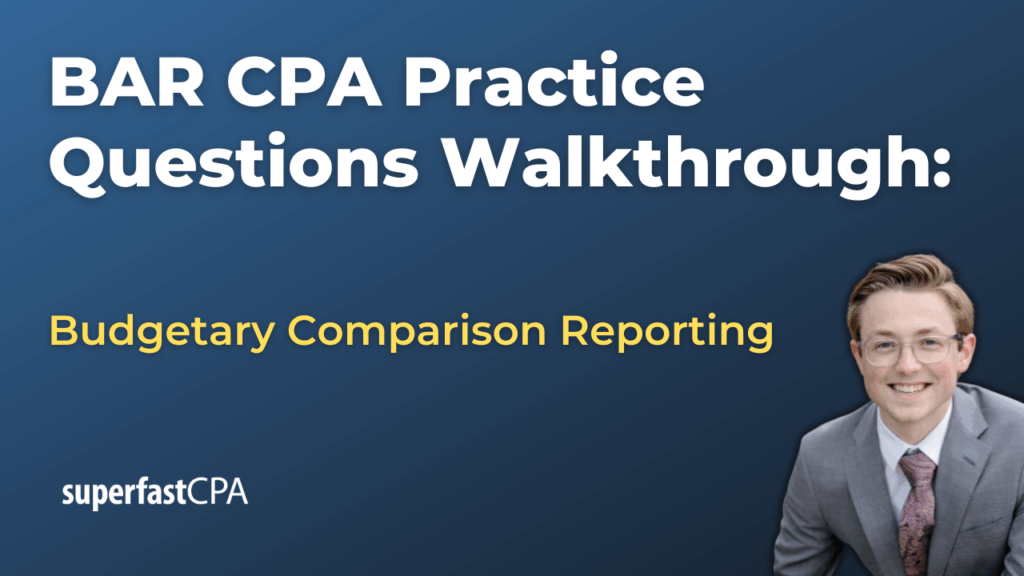In this video, we walk through 5 BAR practice questions teaching about budgetary comparison reporting. These questions are from BAR content area 3 on the AICPA CPA exam blueprints: State and Local Governments
The best way to use this video is to pause each time we get to a new question in the video, and then make your own attempt at the question before watching us go through it.
Also be sure to watch one of our free webinars on the 6 “key ingredients” to an extremely effective & efficient CPA study process here…
Budgetary Comparison Reporting
Budgetary comparison reporting is a fundamental element of governmental financial reporting. It provides transparency regarding how a government adhered to its legally adopted budget and demonstrates accountability to citizens and oversight bodies. This topic addresses the objectives and components of budgetary comparison reporting as required in the Annual Comprehensive Financial Report (ACFR) for state and local governments.
Objective of Budgetary Comparison Reporting
The primary objective of budgetary comparison reporting is to demonstrate accountability and legal compliance with the government’s adopted budget. In governmental accounting, the budget functions as a legally binding financial plan that establishes spending authority. The comparison schedule allows users to assess whether the government’s actual revenues and expenditures were consistent with the amounts authorized.
For example, if a city’s general fund budget authorized $80 million in expenditures and the city spent $77 million, the budgetary comparison schedule reveals this compliance. It provides clear evidence that spending was within the legally approved limits.
Funds Requiring Budgetary Comparison Reporting
According to GASB standards, budgetary comparison schedules are required only for:
- The General Fund, and
- Special Revenue Funds that have a legally adopted annual budget.
These are the funds most directly subject to legally imposed spending controls. Other funds—such as capital projects, debt service, proprietary, or fiduciary funds—are not required to present budgetary comparison schedules unless the government elects to provide them voluntarily.
Example:
A county’s “Public Health Special Revenue Fund” with an annually adopted budget must include a budgetary comparison schedule. However, its “Water Utility Enterprise Fund” would not be required to do so because proprietary funds are not legally budgeted in the same manner.
Basis of Presentation and Reconciliation to GAAP
The budgetary comparison schedule must be presented on the budgetary basis of accounting actually used in preparing and adopting the budget. Many governments use a cash or modified accrual basis for budgeting, which may differ from the GAAP basis used in financial reporting.
When these bases differ, the government must provide a reconciliation between the budgetary results and GAAP amounts. This reconciliation can appear either on the face of the schedule or in the notes to the financial statements.
Example:
If a city adopts its budget on a cash basis but reports in the financial statements using the modified accrual basis, the reconciliation might adjust for unpaid obligations or receivables. This ensures users understand how the legally adopted budget ties to GAAP financial reporting.
Required Components of the Budgetary Comparison Schedule
Each budgetary comparison schedule must contain three essential components:
- Original Budget – The budget formally adopted by the governing body at the beginning of the fiscal year.
- Final Amended Budget – The legally authorized budget after all approved amendments or supplemental appropriations.
- Actual Results – The government’s actual revenues and expenditures, reported on the budgetary basis of accounting.
An additional formal requirement is that governments also include a variance column showing the difference between budgeted and actual amounts. This additional information helps users easily identify over- or under-spending.
Example:
If the final budget for police services was $50 million and actual spending was $49.2 million, the variance column would show a $0.8 million favorable variance, indicating that the department remained within its authorized spending level.
Information Needed to Prepare the Budgetary Comparison Schedule
To prepare a complete and accurate budgetary comparison schedule, a government must gather and reconcile several key pieces of information:
- The original adopted budget approved by the governing body.
- The final amended budget incorporating all legally enacted changes.
- The actual results on the same budgetary basis used for the budget.
- Variance calculations between budgeted and actual amounts.
- GAAP reconciliation, if the budgetary basis differs from GAAP.
These elements together provide a clear depiction of budgetary compliance and the government’s ability to manage resources in line with legal authority.
Presentation and Placement in the ACFR
Budgetary comparison schedules are classified as Required Supplementary Information (RSI) within the ACFR. RSI appears after the notes to the financial statements and is subject to limited audit procedures rather than a full audit opinion.
Example:
Some municipalities choose to present the general fund budgetary comparison immediately following the fund financial statements. Others retain it in the RSI section for a more standardized layout consistent with other supplementary disclosures, such as pension or OPEB schedules.
Importance and Interpretive Value
Budgetary comparison reporting enhances both transparency and decision-usefulness in governmental financial statements. It allows:
- Citizens and oversight bodies to evaluate whether public resources were used in accordance with the adopted budget.
- Financial analysts and auditors to assess fiscal discipline and adherence to statutory constraints.
- Management to identify operational efficiencies and areas for future improvement.
Example:
If a school district’s instructional services budget was $120 million and actual expenditures were $118 million, the schedule clearly shows a $2 million favorable variance. Stakeholders can interpret this as evidence of effective budgetary control and financial responsibility.
Summary
Budgetary comparison reporting is a cornerstone of governmental financial accountability. It links financial planning to actual performance, illustrating how closely operations followed the legally adopted and amended budgets.
By requiring governments to present this information on the budgetary basis and reconcile it to GAAP when necessary, GASB ensures both legal compliance and comparability in public financial reporting. The budgetary comparison schedule is one of the most valuable tools for understanding a government’s stewardship of public funds.










